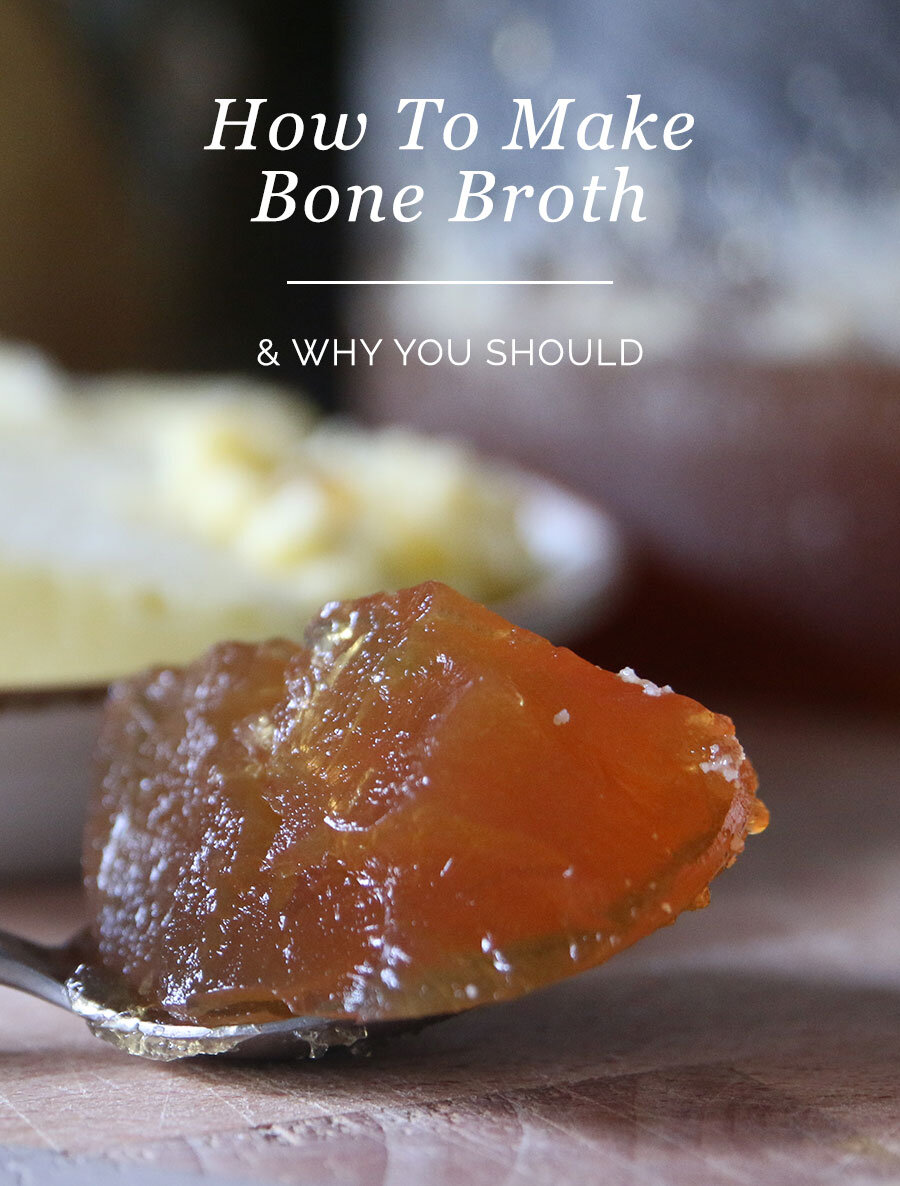How To Make Bone Broth (and why you should)
My mother has crippling rheumatoid arthritis.
She's nearly 60 years old and this has been a persistent disease in her life since she was 16 years old.RA is a disease of the immune system and is exasperated by any inflammatory foods such as gluten, refined sugar, dairy, alcohol or artificial flavours and preservatives.
Mum has tried many things in her life to ease her pain and is currently very heavily medicated, yet she has only just now reached the point where she is willing to do something many people feel is 'drastic'... and try to heal as much as she can through diet.One of our first points of call is bone broth.
Though mum doesn't eat meat, she has decided to introduce broth into her diet because the benefits are simply too good to say no to.
Personally I don't feel they can be found elsewhere at this high a level of nutrient density.
Why should you eat bone broth?Nutrition researchers Sally Fallon and Kaayla Daniel of the Weston A. Price Foundation explain that bone broths contain minerals in forms that your body can easily absorb: calcium, magnesium, phosphorus, silicon, sulphur and others.
They contain chondroitin sulphates and glucosamine, the compounds sold as pricey supplements to reduce inflammation, arthritis and joint pain.
Bone broth is exceptionally high in the amino acids proline and glycine which are vital for healthy connective tissue (ligaments, joints, around organs.
Can improve digestion, allergies, and immune health - improving the health of the brain in the process (95% of our brain chemicals/hormones are formed in the gut.)
Aids in the reduction of autism, dyslexia, ADD, ADHD, dyspraxia, depression and schizophrenia (read guts and psychology syndrome)
Information for parents of children with attention related disordersMost children who show symptoms of a psychiatric, behavioural, or mood disorder are also suffering from immune dysregulation and/or gut dysbiosis–two medical conditions that are treatable.Currently, prescription medications that are used to treat many of these conditions simply mask the symptoms and do not address the root cause.
These same prescription medications (if taken for a prolonged period in childhood) are known to statistically increase the risk of adult depression in children and also damage the digestive system themselves, the area that most needs to be supported to heal.Gut an immune health in children is of critical importance. As with autism, dysfunction in the gut leads to dysfunction in the brain and with bone broth being one of the most nutrient rich foods known to help the digestive system heal, it goes without saying that it is an excellent addition to your child's diet.
I would also recommend removing other inflammatory and digestive damaging foods such as gluten, refined sugar and all artificial colourings, flavourings and preservatives.
Beef Bone Broth Recipe
about 2-3kg of bones. Grass-fed and hormone free is best. If they are large marrow bones, like I use - have the butcher chop them up for you into smaller parts. Although they have less meat, they seem to have more gelatin. My one year-old eats the marrow out of the bones after they've boiled. Toddler does not approve. ;)
about 3-4 litres of cold water
1/4 cup vinegar (this is a must as it draws the minerals out of the bones)2-3 onions, coarsely chopped3 carrots, coarsely chopped3 celery stalks, coarsely choppedseveral sprigs of fresh thyme, tied together1 teaspoon dried peppercorns, crushed or a tsp black peppercorns
Bone-Broth-Pot-Gut-Health
Add the bones with no meat on them to a large stock pot and cover with the water. Place the meaty bones in a roasting pan and brown at 180C or 350F. Add to the pot along with the vegetables, vinegar, herbs and pepper.
Bring to the boil and then reduce, whack a lid on the pot and simmer for 24-72 hours. YES! 24-72 hours, I usually do mine for 24 hours.You can turn the stove top off at night and then turn back on to a simmer in the morning if you're worried about the stove being on overnight.
If there is brown gross looking 'foam' on top, skim it off with a spoon.
If you want your broth to become 'jelly-like' like mine in the image below, you will need to simmer the liquid has reduced in volume by at least half.
Remove the bones and strain the liquid into a container, then cool, allowing the fat to harden then you can remove it and throw it away OR you can keep and use the fat (it's called tallow) to cook or fry with. It has a high smoke point and is nutritious in itself.
Tallow is:
Almost 50% monounsaturated fat
May have positive impact on reducing cancer growth
Grass-fed beef fat has a high concentration of “conjugated linoleic acid,” or CLA, which is good to lower cholesterol levels. (See here for more.)
Refrigerate the broth within 3-4 days or freeze and keep for up to a year.
Where to use the broth
Add a teaspoon to a cup of warm water and drink it like a tea
Add the jelly or broth to your spaghetti bolognese sauce
Add the jelly or broth to your macaroni and cheese mix
Use it in stews, curries or warm dishes just like stock (the BEST stock!)
Add it to dips (I add it to my hummus)
Make risotto using the broth and (soaked and cooked) rice



